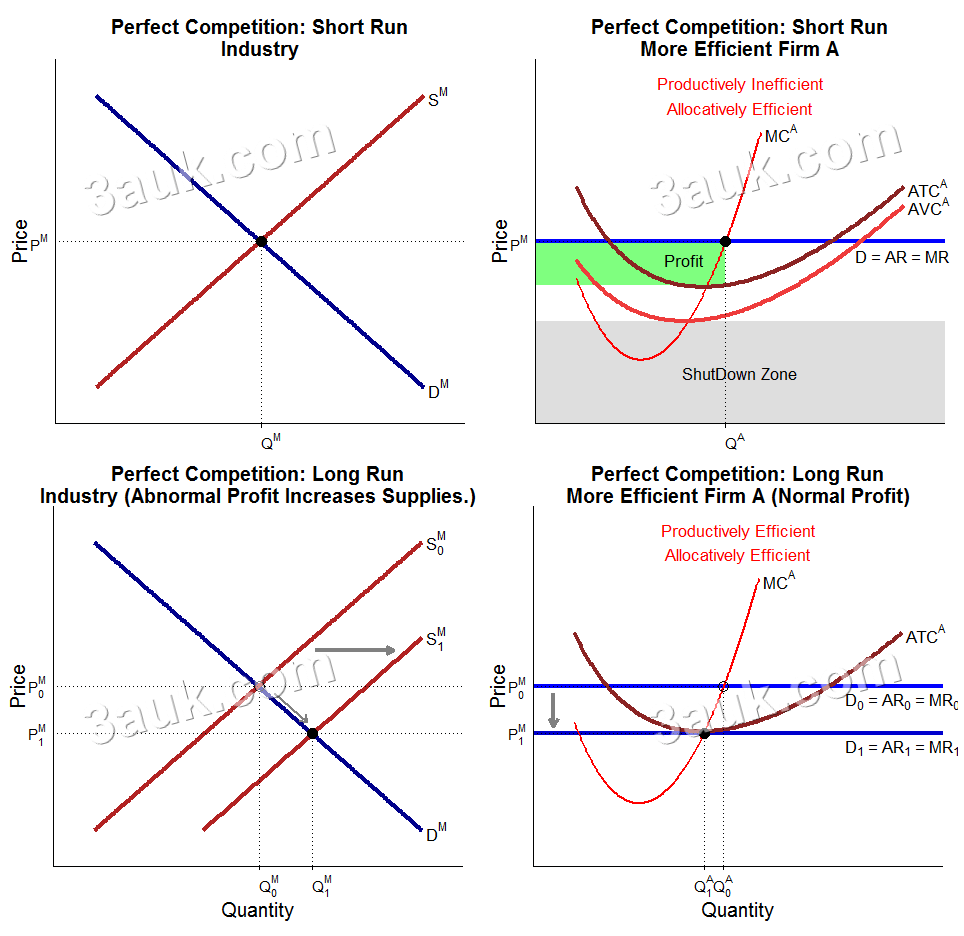Content
short run and long run analysis: output, profits, entry and exit, efficiency

- In the short run, firms in perfect competition behave as price takers, meaning they have no control over the market price and must accept the price determined by the industry.
- The firms can, however, adjust their output level to maximize their profit, which is calculated as total revenue minus total cost.
- If the market price is greater than the firm's average variable cost, the firm will continue to produce in the short run.
- If the market price is less than the firm's average variable cost, the firm will shut down and incur a loss equal to its fixed cost.
- In the long run, firms can enter or exit the industry depending on the level of profits.
- If firms are making profits in the industry, new firms will enter, which will increase the supply and reduce the price until profits are equal to zero.
- If firms are making losses in the industry, some firms will exit, which will decrease the supply and increase the price until profits are equal to zero.
- In the long run equilibrium, firms in perfect competition will earn normal profits, meaning they will earn just enough to cover their opportunity cost of production.
- Firms in perfect competition in the long run are considered to be efficient as they produce at the minimum average total cost and do not have any market power to distort the allocation of resources. The industry as a whole is also considered efficient as it produces at the minimum efficient scale.
shutdown price in the short run and the long run

In economics, the shutdown price refers to the minimum price that a firm must receive in order to continue producing in the short run.
- In the short run, a firm will continue to produce as long as its total revenue is greater than its total variable cost, even if it is making a loss. However, if the price falls below the shutdown price (average variable cost), the firm will stop producing and shut down in the short run to avoid incurring losses greater than its fixed costs.
- In the long run, if the price remains below the average total cost, the firm will exit the market since it cannot sustain losses indefinitely. The shutdown price in the long run is the minimum price that covers both variable and fixed costs, allowing the firm to break even.
- For example, a firm producing widgets may have a shutdown price of $10 in the short run, meaning that if the price of widgets falls below $10, the firm will stop producing and incur losses. In the long run, the shutdown price may increase to $12 if the firm incurs higher fixed costs, and if the price falls below $12, the firm will exit the market.
derivation of a firm’s supply curve in a perfectly competitive market

- The supply curve of a firm in a perfectly competitive market is derived based on the marginal cost (MC) curve of the firm.
- In perfect competition, the firm is a price taker and cannot influence the market price of the product. Therefore, the firm's marginal revenue (MR) curve is a horizontal line at the market price.
- In the short run,
- if the market price is greater than the minimum point of the average variable cost (AVC) curve, the firm will produce the quantity where the MC curve intersects the marginal revenue (MR) curve.
- This is because any revenue above the AVC will help cover the fixed cost or make a profit.
- The supply curve of the firm is the portion of the MC curve that lies above the AVC curve.
- If the market price is less than the minimum point of the AVC curve, the firm will shut down production in the short run since it cannot cover its variable costs.
- The supply curve of the firm in this case is the portion of the MC curve that lies above the shutdown point, which is the point where the MC curve intersects the AVC curve.
- if the market price is greater than the minimum point of the average variable cost (AVC) curve, the firm will produce the quantity where the MC curve intersects the marginal revenue (MR) curve.
- In the long run, all factors of production are variable, and firms can enter or exit the market freely. If firms are earning positive profits in the short run, new firms will enter the market in the long run, which will increase the supply and lower the market price. If firms are experiencing losses in the short run, some firms will exit the market in the long run, which will decrease the supply and increase the market price.
- In the long run, the firm will produce at the minimum point of the long-run average cost (LRAC) curve, which represents the most efficient level of production. The supply curve of the firm in the long run is the portion of the MC curve that lies above the LRAC curve. If the market price is less than the minimum point of the LRAC curve, the firm will exit the market in the long run.
Join the conversation